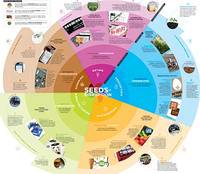Future Now
The IFTF Blog
Four Forecast Perspectives: Remaking Food Experiences
 We’re entering a curious world of spoons that help us eat, veggie burgers made with plant blood, virtual meals and drone delivery. How will these technologies interact with changing human needs and desires? What lengths will we go to for convenient food experiences? How will we know if our food was sustainably produced? How fresh can we get it, and what will that mean? How will we define satisfaction?
We’re entering a curious world of spoons that help us eat, veggie burgers made with plant blood, virtual meals and drone delivery. How will these technologies interact with changing human needs and desires? What lengths will we go to for convenient food experiences? How will we know if our food was sustainably produced? How fresh can we get it, and what will that mean? How will we define satisfaction?
In our 2013 research, we explored how people will interact with this emerging set of technologies to demand new kinds of satisfying food experiences. We created four Forecast Perspectives, essays and artifacts from the future that explore the human experience of food in this new world. The full text and images are available at the links below and as a free download.
![]() In combination with our map of the decade, Seeds of Disruption: How Technology is Remaking the Future of Food, these forecast perspectives offer a tool for exploring the edges of technological possibility in food and developing insights into how to use them to meet human values and needs.
In combination with our map of the decade, Seeds of Disruption: How Technology is Remaking the Future of Food, these forecast perspectives offer a tool for exploring the edges of technological possibility in food and developing insights into how to use them to meet human values and needs.
Four Forecast Perspectives: Remaking Food Experiences
Satisfaction | Personalized Cravings
High-resolution biology ushers in a new science of food satisfaction
Findings from neurobiology, genetics, and other biological sciences are suggesting that the factors that make us satisfied—that make us feel that we got what we wanted out of food, be it satiety, taste, or other effects—vary by person, sometimes down to the cellular level. Knowledge of the myriad ways that people’s bodies metabolize fuel will spur new efforts to design foods not just for taste appeal but also to enhance energy, improve mood, and increase other long-term feelings of satisfaction. These efforts will converge with new attempts to design the context around food—including colors, smells, and sounds—to create eating experiences that satisfy the whole person.
Convenience | Rethinking Shopping
Just-in-time delivery transforms consumer understandings of convenience
Over the next decade, the convergence of two forces will reshape consumers’ expectations about convenient food. First, as food shopping shifts from an activity performed in a restaurant or supermarket to something consumers engage in while driving, sitting at home, or waiting for the train, distinctions between fresh and fast food will blur. Second, automated systems for delivery will turn packaged foods into automated purchases. As these forces converge, they will transform any moment into an opportunity to shop and make obsolete many of the reasons to go shopping in a brick-and-mortar store.
Freshness | Quantifying Peak Flavors
New technologies augment freshness and flavor experiences across the food chain
New technologies in the next decade will give us an unprecedented ability to satisfy our cravings for fresh, flavorful food. Fueled by ubiquitous urban agriculture, new models of food retail, and breakthroughs in the understanding of taste perception, innovations across the food chain will tap into urban spaces, homes, and even our bodies to optimize for freshness and taste. We’ll see a proliferation of what fresh and flavorful can mean—and opportunities to expand markets—as the distance between production and consumption decreases, freshness and convenience become more aligned, and consumer appetites for customized eating experiences grow stronger.
Sustainability | Sourcing Mindfulness
Food Production Keeps Pace with Other Aspects of Sustainability
In the next decade, sustainable food production will be fueled by the passion and creativity of chefs from whom people get more and more of their food and their meal ideas—directly from restaurants or indirectly from the ready-to-eat sections of retailers and from cooking lessons on television. Local, fresh, and flavorful will be the hallmarks of foods that sneak health and sustainability in under the guise of taste. Reassured by an increasingly transparent and hyper-local system of food production, consumers’ sense of responsibility for choosing sustainable food will shift toward mindful consumption and waste reduction.
This post is part of IFTF’s food futures research, which brings systematic futures thinking to food system efforts around the world. Our long-term view encompasses multiple scales, levels of uncertainty, and radically different possible futures. We develop foresight to help others develop insight and take action toward impactful, transformative, resilient change.
Interested in learning more?
For more information about our research, sponsorships, collaborations, and events, please contact:
- Rebecca Chesney at rchesney@iftf.org



